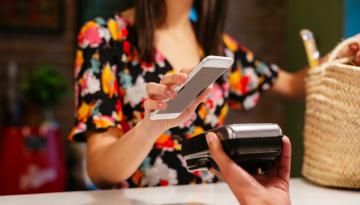
A woman in the UK is gobsmacked after finding she was charged £1,599 (NZ$3095) for a bunch of bananas that should have cost £1.
Grocery shopping, particularly top-up purchases - such as bread, milk and fruit - is often done in a hurry, on the way to or from work, with hungry or tired kids in tow, or maybe on a Sunday evening when we'd rather be relaxing ready for the week ahead.
But the experience of one woman shows it's important to stay alert to overcharges, particularly when paying for items electronically.
After rushing through a small Marks and Spencer self-service checkout, 28-year-old Londoner Cymbre Barnes happened to glance at her phone when she saw the amount of £1,599 (NZ$3095) flash up on the screen.
She'd used Apple Pay, a contactless payment service that allows users to quickly pay for goods using their iPhone. After seeing how much she'd be charged immediately after the sale, the woman did a "double-take".
"I was in a rush before work so when I got to self-checkout I used contactless and it was instant," Barnes told The Telegraph.
"I did a double-take when I saw the screen but by then my receipt was already being printed. It was too late."
Told by staff that the only till in the shop was broken and wouldn't be fixed for a week, Barnes was forced to go to another Marks and Spencer store, a 45 minute walk away, to get her money back.
A Marks and Spencer spokesman told The Telegraph there had been huge innovation in contactless payment options for customers, on which the store had received great feedback.
"This was an isolated payment error, for which we've apologised to the customer and offered compensation," the spokesman said.
In New Zealand, Retail NZ chief executive Greg Harford said ApplePay is accepted anywhere that takes contactless payments.
It works using a user's personal credit or debit card information, including their credit limit. Instead of carrying a physical card, consumers simply tap their iPhone to pay.
Chris Lamers, deputy group CEO at Humm Group, confirmed in New Zealand, Apple Pay has a $200 limit. For transactions valued above $200, users are required to enter a PIN, meaning they're likely to pick up any large overcharges before a payment goes through.
"The transaction does flash up on your phone screen (unlike a credit card), so you can see if there's a mistake," Lamers says.
Consumer NZ head of research Jessica Wilson said as electronic payments make it easy to tap a phone or card, consumers may not notice if they're overcharged.
As one-off, genuine mistakes can happen, Wilson suggests checking receipts and scanning bank accounts regularly - and acting quickly on any incorrect charges.
"If you notice a mistake, go back to the retailer straight away and ask them to put it right (reverse the transaction or provide a refund) - even if it's not until you notice it on your bank statement," Wilson says.


